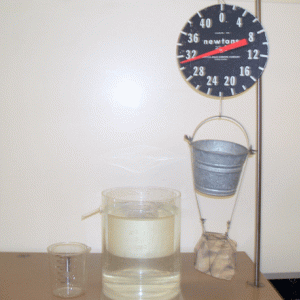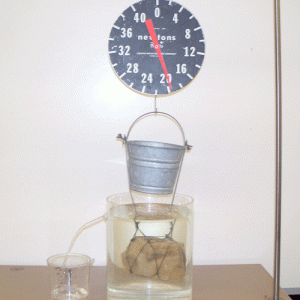College of Liberal Arts & Sciences
2B40.20 - Buoyancy Demo - Archimedes' Principle and Applications
Video Credit: Jonathan M. Sullivan-Wood.
Make sure to pull the plug and equalize the water level in the bucket several minutes before you drop the rock in so that you know that the water you collect is equal to the volume of the rock. When the rock is dropped in the scale will decrease about 10 Newton's. Pour the water back into the small bucket and the scale will go back to the starting weight.
- Armand Le Noxaic, Clemence Alglave, "Is There a Buoyant Force That Acts on a Submerged Object with No Liquid Under It?", TPT, Vol. 62,, #8, Nov. 2024, p. 682.
- Terrence Toepker, "Archimedes Revisited and Beyond", TPT, Vol. 61, #9, Dec. 2023, p. 780.
- Jarier Wannous, Milan Kovac, "Introducing Archie - A Useful Tool for Teaching Archimedes' Principle", TPT, Vol. 59, #8, Nov. 2021, p. 635.
- "Erratum: Betting on Better Buoyancy? Be Careful What You Wish For", TPT, Vol. 58, #8, Nov. 2020, p. 533.
- Willson J. Gonzalez-Espada, Brooke S. Jones, "Betting on Better Buoyancy? Be Careful What You Wish For", TPT, Vol. 58, #6, Sept. 2020, p. 413.
- Ker Liang Goh, "Archimedes’ Principle Using Energy Considerations", TPT, Vol. 56, #9, Dec. 2018, p. 616.
- Paul Hewitt, "Solution to September Figuring Physics", TPT, Vol. 55, #7, Oct. 2017, p. 443.
- Jeffrey Bierman and Eric Kincanon, "Archimedes' Principle and the FCI", TPT, Vol. 41, #5, Dec. 2003, p. 510.
- Hasan Fakhruddin, "An Archimede's Principle Activity", TPT, Vol. 40, #6, Sept. 2002, p. 376.
- Boon Leong Lan, "Don't Run Naked and Shout Eureka! Yet", TPT, Vol. 38, #2, Feb. 2000, p. 125.
- Thomas Bruce Daniel, "Archimedes' Principle Without the King's Crown", TPT, Vol. 36 # 9, Dec. 1998, p. 557.
- Paul Hewitt, "Figuring Physics", TPT, Vol. 35, #5, May 1997, p. 291.
- Iain MacInnes and Rory McPherson, "The Hydrostatic Balance Revisited", TPT, Vol. 34, #8, Nov. 1996, p. 500.
- John D. McGervey, "Hands-on Physics For Less Than A Dollar Per Hand-Part II", TPT, Vol. 34, #7, Oct. 1996, p. 448.
- Marc Rosner, "Practical Hydrodynamics", TPT, Vol. 34, #6, Sept. 1996, p. 326.
- Paul Hewitt, "Figuring Physics", TPT, Vol. 34, #3, Mar. 1996, p. 169.
- Van E. Neie, "Beware of Greeks Bearing Pan Balances", TPT, Vol. 33, #1, Jan. 1995, p. 6.
- David A. Ward, "Ward's Response", TPT, Vol. 33, #1, Jan. 1995, p. 6.
- Ronald Ebert, "Does the Buoyant Force Depend on the Weight or Density?", TPT, Vol. 32, #5, May 1994, p. 262.
- David A. Ward, "Finding the Buoyant Force", TPT, Vol. 32, #2, Feb. 1994, p. 114.
- C. Guerra-Vela and D. J. Bord, "Composite Samples for an Archimedes' Principle Experiment", TPT, Vol. 26, #2, Feb. 1988, p. 95.
- Robert P. Bauman, "Archimedes' Bath", TPT, Vol. 25, #3, Mar. 1987, p. 162.
- D. Easton, "Archimedes Revisited", TPT, Vol. 23, #5, May 1985, p. 294.
- Roland A. Hultsch, "An Application of Archimedes' Principle: Eureka! I'm 28% Fat", TPT, Vol. 19, #6, Sep. 1981, p. 408.
- John R. Ray, Eric Johnson, "Removing the Buoyant Force, a Follow-Up", TPT, Vol.17, #6, Sept. 1979, p. 392.
- Gordon E. Jones and W. Paul Gordon, "Removing the Buoyant Force", TPT, Vol.17, #1, Jan. 1979, p. 59.
- Lillian Hartman Hoddeson, "How Did Archimedes Solve King Hiero's Crown Problem? - An Unanswered Question", TPT, Vol. 10, #1, Jan. 1972, p. 14.
- V. M. Rudiak, "A Proof of Archimedes' Principle", TPT, Vol. 2, #6, Sept. 1964, p. 293.
- Harley J. Haden, "A Demonstration of Newtonian and Archimedean Forces", TPT, Vol. 2, #4, Apr. 1964, p. 176.
- Augustine C. Chen, "Letters - Archimedes' Principle", AJP, Vol. 50, #6, June 1982, p. 491.
- Pau-Chang Lu, "Letter - Archimedes", AJP, Vol. 50, #11, Nov. 1982, p. 968.
- Pau-Chang Lu, "Letters - More on Archimedes' Principle", AJP, Vol. 50, #11, Nov. 1982, p. 968.
- Mark Wilson, "Archimedes's Principle Gets Updated", Physics Today, Vol. 65, #9, Sept. 2012, p.15.
- Fg-1: Freier and Anderson, A Demonstration Handbook for Physics.
- F-105: "Archimedes' Cup and Can", DICK and RAE Physics Demo Notebook.
- M-283, 284: Richard Manliffe Sutton, Demonstration Experiments in Physics.
- Tik Liem, "How Can We Determine the Rock's Volume?", Investigation to Science Inquiry, p. 403.
- Martin Gardner, "How to Measure Volume", Science Tricks, p. 16.
- Rick Beyer, "Bath Time", The Greatest Science Stories Never Told, p. 2.
- B.Camerin Reed, "Archimedes' Law Sets A Good Energy-Minimization Example", Physics Education, Vol. 39, #4, July 2004, p. 322.
- Julius Sumner Miller, Q38 & A38, Millergrams I – Some Enchanting Questions for Enquiring Minds, p. 33 & 89.
- Joseph Frick, "# 84 - Loss of Weight in Water", Physical Technics: Or, Practical Instructions for Making Experiments in Physics and the Construction of Physical Apparatus with the Most Limited Means", p. 92.
- D. Colson, C. J. Lapp, J. A. Eldridge, "Experiment VI", 1936 Univ. of Iowa Physics Laboratory Manual, p. 13.
Disclaimer: These demonstrations are provided only for illustrative use by persons affiliated with The University of Iowa and only under the direction of a trained instructor or physicist. The University of Iowa is not responsible for demonstrations performed by those using their own equipment or who choose to use this reference material for their own purpose. The demonstrations included here are within the public domain and can be found in materials contained in libraries, bookstores, and through electronic sources. Performing all or any portion of any of these demonstrations, with or without revisions not depicted here entails inherent risks. These risks include, without limitation, bodily injury (and possibly death), including risks to health that may be temporary or permanent and that may exacerbate a pre-existing medical condition; and property loss or damage. Anyone performing any part of these demonstrations, even with revisions, knowingly and voluntarily assumes all risks associated with them.

